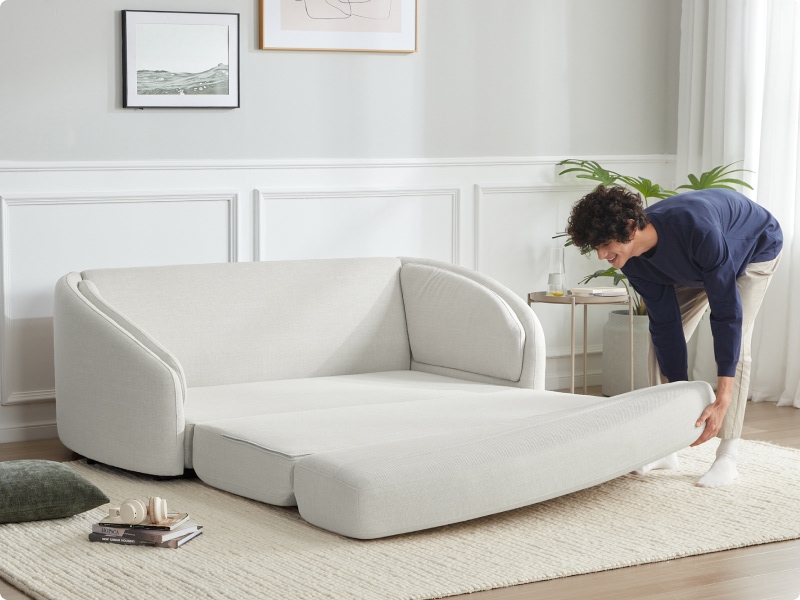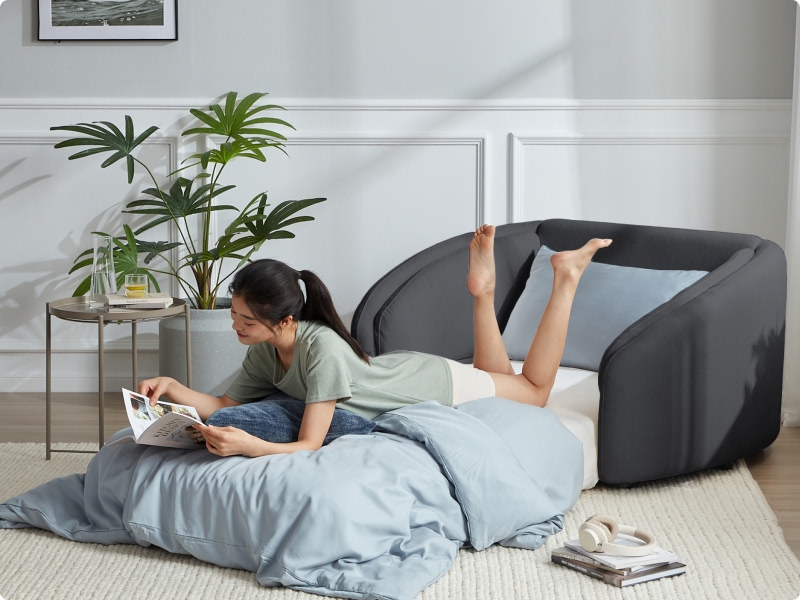Maximising Studio Space: Sofa Bed and Other Space-Saving Furniture for Musicians
Music is a major part of Australia’s cultural fabric. The country’s live music industry alone employed 41,000 individuals as per 2019-2020 data, 63% of whom were in New South Wales and Victoria. (1)
If music is food for the soul, musicians are chefs carefully preparing meals for our musical nourishment. Rather than stoves and pans, they need a functional recording studio with high-quality audio equipment and acoustic treatment to achieve the best sound quality.
Apart from having the right gear, picking essential furniture pieces is just as important. Consider this curated list of furnishings to maximise valuable floor space in your existing or upcoming music studio.
Sofa Bed
While more popular for optimising living spaces, studio owners can use a sofa bed as a makeshift guest area. Convertible sofas offer comfortable seating for most of the day and transform into a sleeping area at night time. That’s why they’re also known as “sleeper couches” or “couch beds.”
Musicians are known to live extremely busy lives. After all, being one doesn’t pay well unless you’re popular. About 50% of musicians earned below AUD$ 6,000 in 2023— reflecting 15% of the national minimum pay. Many of them hold either a full-time or part-time job to survive. As such, they’re likely to seek a comfortable studio space when recording or practising. (2)
Sleeper couches come in various space-saving designs and offer a cosy place to rest. If you’re trying to work around cramped spaces, a 2 seater sofa bed can be a good option. Those with bigger studios should consider getting a modular sofa for flexible seating requirements.
Multi-Purpose Furniture
Creativity and performance don’t automatically show up sometimes. That’s why musicians could spend hours or days in music studios. They also need to sit, stand, eat, move around, or take a nap. Compact desks could be a solution, but you can take this further by getting multi-functional furniture.
For example, you can use a convertible desk either as a standing digital audio workstation or a regular sitting desk. Standing desks have gained popularity in recent years because of purported health benefits. Estimates show its market value will reach USD$ 12.6 billion (AUD$ 19.9 billion) by 2032. (3)
Switching positions promotes good posture and blood flow while reducing fatigue during lengthy mixing or recording sessions. Even so, a recent study has discovered that prolonged standing alone can’t reverse the negative health impacts of sitting for more than 10 hours. Scientists found that staying active or moving around is the only key. (3)
Still, you can’t have a music studio without seating surfaces. If you don’t want to sit for too long, you can get ottomans with storage compartments that you can use to store small equipment. Too small for your needs? Check whether your furniture seller has sofa beds with drawers.
Modular Units
These are sold as a set and comprise individual and interchangeable units that you can reconfigure to fit different spaces and needs.
Modular cabinet systems are small enough to fit compact spaces yet large enough to store instruments, equipment, and accessories. These space-saving furniture are your best bet if you want to keep your studio clutter-free and organised.
Otherwise, you can opt for nesting tables, a set of tables that fit neatly together but can be used individually for various purposes. These versatile furniture pieces can be used for writing lyrics and composing music or as coffee tables and dining tables for one or two people.
Wall-Mounted Furnishings
Wall-mounted storage solutions work great for tight spaces because they maximise vertical space. You can install wall-mounted racks or shelves to store gear, sheet music, and other items that could mess up your workspace. Plus, you can mount instruments and display them in a visually appealing way to add to your music studio aesthetics.
You can likewise use a wall-mounted drop-leaf table as a dining table or desk. When not in use, you can fold and tuck it flat against the wall.
Foldable and Expandable Furniture
Users can collapse, adjust, or expand these pieces to save space and provide flexibility. Fold-down tables and chairs can be set up when needed and neatly set aside when not in use. This functionality frees up a portion of your already limited space.
You can adjust an expandable desk or table’s height and width to perform different tasks, for instance, recording, writing, or mixing. With these capabilities, you won’t have problems making room for additional people during recording or brainstorming.
For additional vertical storage solutions, use adjustable shelving units. Collapsible chairs can also have built-in storage compartments for smaller items like cables and microphones.
Hidden Storage Compartments
When it comes to creating hidden compartments, you’re not limited to bookshelf doors. For example, you can design acoustic panels that double as smart storage solutions. Your studio can likewise benefit from under-floor storage compartments to hold instrument cases and amplifiers. It’ll be easier to prepare for a live performance when you have everything you need.
If an extensive renovation is out of the question, you can always settle for under-desk drawers and cabinets to neatly tuck away smaller items. Have an old piano with sentimental value? Use its body as a storage area to keep your studio neat and clean.
Concluding Thoughts
Building a music studio requires more than state-of-the-art equipment and impeccable acoustic treatment. To keep your studio functional, you must consider it as an extension of your living space. Choose every piece of furniture to boost your comfort and workflow.
With space-saving furniture and creative solutions, you can optimise every square footage and turn your compact space into a musical sanctuary. Staying free from spatial limitations empowers you to think out of the box and unlock your creative potential.
Citations:
- “Australia’s live music sector: an occupation-based analysis”. Source: https://www.infrastructure.gov.au/sites/default/files/documents/Australia%27s%20live%20music%20sector%20-%20an%20occupation-based%20analysis%20-%20March%202023%20-%20PDF.pdf
- “Media, Entertainment and Arts Alliance finds half of Australian musicians earned less than $6,000 last financial year”. Source: https://www.abc.net.au/news/2024-04-02/meaa-survey-finds-musicians-earning-less-post-pandemic/103659484
- “Standing desks may be bad for your health, new research finds”. Source: https://edition.cnn.com/2024/11/12/health/standing-desks-health-effects-wellness/index.html


